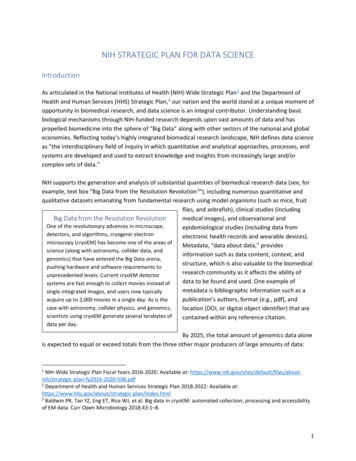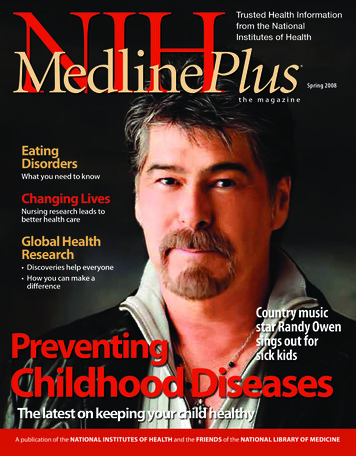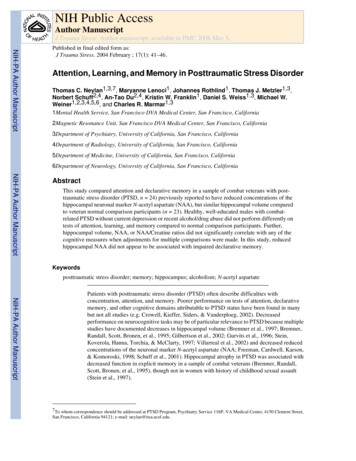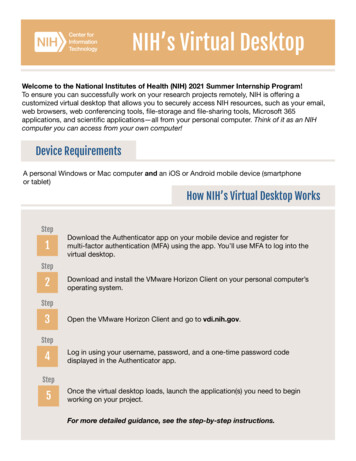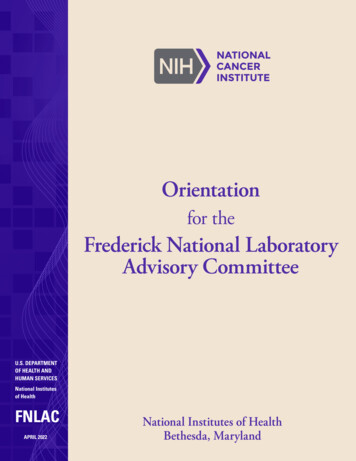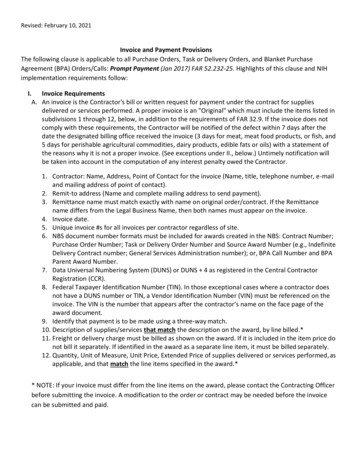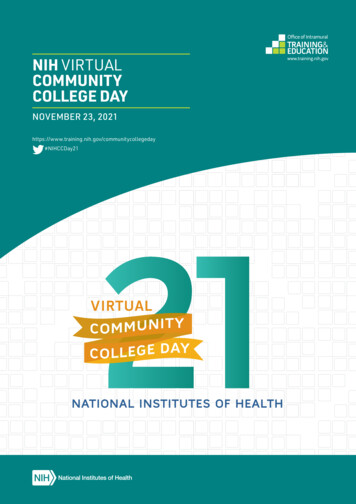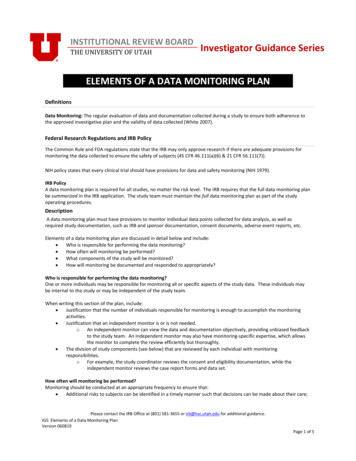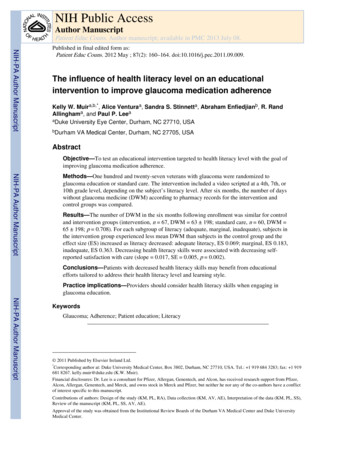
Transcription
NIH Public AccessAuthor ManuscriptPatient Educ Couns. Author manuscript; available in PMC 2013 July 08.NIH-PA Author ManuscriptPublished in final edited form as:Patient Educ Couns. 2012 May ; 87(2): 160–164. doi:10.1016/j.pec.2011.09.009.The influence of health literacy level on an educationalintervention to improve glaucoma medication adherenceKelly W. Muira,b,*, Alice Venturaa, Sandra S. Stinnetta, Abraham Enfiedjianb, R. RandAllinghama, and Paul P. LeeaaDuke University Eye Center, Durham, NC 27710, USAbDurhamVA Medical Center, Durham, NC 27705, USAAbstractObjective—To test an educational intervention targeted to health literacy level with the goal ofimproving glaucoma medication adherence.NIH-PA Author ManuscriptMethods—One hundred and twenty-seven veterans with glaucoma were randomized toglaucoma education or standard care. The intervention included a video scripted at a 4th, 7th, or10th grade level, depending on the subject’s literacy level. After six months, the number of dayswithout glaucoma medicine (DWM) according to pharmacy records for the intervention andcontrol groups was compared.Results—The number of DWM in the six months following enrollment was similar for controland intervention groups (intervention, n 67, DWM 63 198; standard care, n 60, DWM 65 198; p 0.708). For each subgroup of literacy (adequate, marginal, inadequate), subjects inthe intervention group experienced less mean DWM than subjects in the control group and theeffect size (ES) increased as literacy decreased: adequate literacy, ES 0.069; marginal, ES 0.183,inadequate, ES 0.363. Decreasing health literacy skills were associated with decreasing selfreported satisfaction with care (slope 0.017, SE 0.005, p 0.002).Conclusions—Patients with decreased health literacy skills may benefit from educationalefforts tailored to address their health literacy level and learning style.Practice implications—Providers should consider health literacy skills when engaging inglaucoma education.NIH-PA Author ManuscriptKeywordsGlaucoma; Adherence; Patient education; Literacy 2011 Published by Elsevier Ireland Ltd.*Corresponding author at: Duke University Medical Center, Box 3802, Durham, NC 27710, USA. Tel.: 1 919 684 3283; fax: 1 919681 8267. kelly.muir@duke.edu (K.W. Muir).Financial disclosures: Dr. Lee is a consultant for Pfizer, Allergan, Genentech, and Alcon, has received research support from Pfizer,Alcon, Allergan, Genentech, and Merck, and owns stock in Merck and Pfizer, but neither he nor any of the co-authors have a conflictof interest specific to this manuscript.Contributions of authors: Design of the study (KM, PL, RA), Data collection (KM, AV, AE), Interpretation of the data (KM, PL, SS),Review of the manuscript (KM, PL, SS, AV, AE).Approval of the study was obtained from the Institutional Review Boards of the Durham VA Medical Center and Duke UniversityMedical Center.
Muir et al.Page 21. IntroductionNIH-PA Author ManuscriptGlaucoma is the leading cause of irreversible blindness worldwide [1,2] anddisproportionately affects older adults and African-Americans in both prevalence andseverity [3–5]. The number of Americans with glaucoma is expected to increase by 50% inthe next 15 years [3]. Multiple studies have shown that with effective medical treatment,much glaucomatous vision loss can be prevented through reduction in intraocular pressure(IOP) [6–9]. Despite this, glaucoma medications often are not instilled as prescribed [10–14]. Multiple factors contribute to glaucoma medication nonadherence, including patients’lack of understanding of the potentially blinding nature of the disease [15,16], and poorhealth literacy [17,18].Health literacy is defined by the Institute of Medicine as “the degree to which individualshave the capacity to obtain, process, and understand basic information and services neededto make appropriate decisions regarding their health [19].” The 2003 National Assessmentof Adult Literacy revealed that more than 75 million adults in the United States possess onlybasic or less than basic health literacy skills [20]. Poor health literacy skills are associatedwith increased rates of hospitalization [21], less use of preventive services [22], andincreased overall mortality [23].NIH-PA Author ManuscriptIn two separate studies, it was found that around 50% of adults with open angle glaucomapossess poor health literacy skills [17,18]. Not only may decreased health literacy skills beassociated with decreased adherence to the prescribed glaucoma medication regimen [17],but patients with lower literacy skills demonstrate more advanced visual field loss than theirmore literate peers [18].NIH-PA Author ManuscriptAlthough the mechanisms connecting health literacy and outcomes in glaucomamanagement are not clear, work in other chronic diseases such as diabetes and hypertensionsuggest that poor disease knowledge and self-management skills may play an intermediaryrole [24]. In a group of patients with poorly controlled diabetes, an educational interventiontargeted to the individual’s health literacy level resulted in improved diabetes control inthose subjects with poor health literacy skills [25]. Recently, in the eye care community,greater attention has been paid to the issue of limited health literacy, but most ophthalmicpatient educational materials are more appropriate for those patients with more advancedliteracy skills [26]. Although more than 10 percent of glaucoma patients scored in the lowestliteracy category on a standardized assessment of health literacy [17], to our knowledge, nopatient educational materials are publicly available for those glaucoma patients functioningat less than a sixth grade reading level [27]. The purpose of this study was to compare theeffectiveness of an educational intervention targeted to an individual’s health literacy levelto routine care in improving glaucoma medication adherence.2. MethodsThe study is a randomized controlled trial in which patients of the Durham Veterans’ AffairsMedical Center with medically treated glaucoma were eligible to participate. InstitutionalReview Board approval was obtained and the study was performed in accordance withHIPAA regulations. Subjects were excluded if their best-corrected visual acuity in the betterseeing eye was less than 20/200, as low vision would interfere with literacy assessment.Subjects who provided informed consent were administered the Mini Mental State Exam[28] (MMSE) to assess cognitive function, the Test of Functional Health Literacy in Adults[29] (ToFHLA) and a brief survey assessing presence of a comorbidity affecting ability toinstill eye drops (yes/no), self-reported disease knowledge and satisfaction with care (Likertscales). All individuals were required to have 18 or higher on the MMSE as significantPatient Educ Couns. Author manuscript; available in PMC 2013 July 08.
Muir et al.Page 3NIH-PA Author Manuscriptcognitive dysfunction would confound the response to the educational intervention. Theprotocol also excluded subjects who had eye surgery in the past month, as ocular medicationmay change frequently in the post-operative period.NIH-PA Author ManuscriptSubjects were randomized in a one-to-one fashion to standard care or an educationalintervention. Standard care involved usual management by the treating ophthalmologist,including any glaucoma education which he or she might provide. The educationalintervention involved a one-on-one session with the study coordinator, lasting approximately20 min. The study coordinator, with a background in ophthalmic research but not clinicalophthalmology, was trained by an ophthalmologist on the content and delivery of theintervention. A sample of interventions was observed by a glaucoma subspecialist to ensurequality and consistency. All subjects in the educational intervention group were shown aninformational video about glaucoma, but the language of the video varied according to thesubjects’ tested health literacy level. Subjects who scored less than 60 on the ToFHLA,indicating inadequate health literacy skills, saw a video scripted at a fourth grade readinglevel. Subjects who scored 60–74 on the ToFHLA, indicating marginal health literacy, saw avideo scripted at a seventh grade reading level. Subjects who scored greater than 74 on thehealth literacy assessment, saw a video scripted at a tenth grade reading level. A glaucomasubspecialist created the scripts and evaluated the content according to the Flesch-KincaidGrade Level assessment in Microsoft Word. In 2–5 min, all three videos used imagery toexplain the anatomy of the eye including the structures involved in glaucoma and examplesof glaucomatous vision loss. Drop instillation techniques were demonstrated. Subjects in theinadequate and marginal literacy groups were also shown diagrams of the eye as the studycoordinator reviewed the educational information. Subjects who scored in the adequatehealth literacy level were given the American Academy of Ophthalmology educationalbrochure about glaucoma, written at a 10th grade reading level.All subjects in the intervention group were also taught how to instill eye drops and asked todemonstrate proper drop instillation technique for the study coordinator. All subjects in theintervention group received a phone call once a month asking if he or she were having anyproblems with the medication.The medical record was reviewed to collect demographic information such as age, gender,self-reported race, glaucoma-related diagnosis, and prescribed medications, includingunilateral or bilateral administration and prescribed frequency of dosing. The VA pharmacyrecords were reviewed to determine the number and frequency of requested glaucomamedication refills over the six months following enrollment.NIH-PA Author Manuscript2.1. Statistical methodsThe primary outcome measure of this study was the number of days without medication(DWM; the difference between the number of days medication was available to the subjectaccording to the pharmacy records and the prescribed dosing and the number of days thatmedication was required over the study period). The number of drops available per bottlewas derived from a previously published study which specified drops according tomedication, bottle size, and manufacturer [10]. If a subject was prescribed more than oneglaucoma medication, the number of DWM for each medication was summed. If thepharmacy records indicated a surplus of medication, the surplus was considered equivalentto an adequate supply of medicine (i.e., for a subject with a surplus of one medication and aninadequate supply of a second medication, the total DWM would reflect only the inadequatesupply).Secondary outcome measures included medication possession ratio (MPR), defined as theratio of the number of days that the medication was available to the number of days thatPatient Educ Couns. Author manuscript; available in PMC 2013 July 08.
Muir et al.Page 4NIH-PA Author Manuscriptmedication was required over the study period. The MPR is derived from the same data asDWM and, as such, is closely related. Both DWM and MPR were calculated because bothmeasures are commonly reported in adherence literature. Presence of comorbid disability,self-reported disease knowledge, and satisfaction with care were also assessed as outcomesin regards to measured health literacy level.First, descriptive statistics were obtained including mean, median and standard deviation.Continuous outcomes and predictors were analyzed with linear regression and continuousoutcomes with dichotomous predictors were analyzed with the unpaired Student’s t-test. Analpha level of 0.05 was used to determine statistical significance.3. ResultsNIH-PA Author ManuscriptBetween September 27th, 2007 and November 18th, 2008, 131 patients of the Durham VAMedical Center Eye Clinic met enrollment criteria and provided informed consent toparticipate in the study. Two subjects withdrew and two subjects were subsequentlyexcluded because they were not prescribed glaucoma medication during the course of thestudy or they had recent intraocular surgery. No subjects were excluded due to inadequatescore on the MMSE. Of the 127 subjects who completed the study, all but one were men,ranging in age from 43 to 87 years. Characteristics of the study participants are described inTable 1.3.1. Medication adherenceAfter comparing days that medication was available according to the pharmacy refill recordsto the number of days that medicine was required, we found that 72 of the 127 subjects(57%) experienced DWM over the six months following enrollment. The number of DWMranged from one week to 549 days (for a subject without three prescribed medications forsix months); mean 142 126 days, median 114 days. Overall, the number of DWM in thesix months following enrollment was similar for the control and the intervention groups(intervention group, n 67, DWM 63 198; standard care group, n 60, DWM 65 198; p 0.708). The response to the intervention, however, varied according to literacylevel. Subjects in the intervention group with inadequate literacy experienced 41 fewerDWM over the study period than subjects with inadequate health literacy in the controlgroup (Table 2).NIH-PA Author ManuscriptComparing the ratio of the number of days that medication was available to the number ofdays that medication was required or medication possession ratio (MPR), the MPR wassimilar for the standard care and intervention groups (intervention group MPR 0.779 0.335; control group MPR 0.779 0.316; p 0.992). Within subgroups of literacy skills,MPR did not differ between the intervention and control groups for subjects with inadequate(p 0.187), marginal (p 0.649), or adequate (p 0.675) health literacy skills.Subjects with inadequate or marginal health literacy skills were more likely to report thepresence of a physical disability which made proper drop instillation more difficult (p 0.020). Decreasing health literacy skills were associated with decreasing self-reportedsatisfaction with care (slope 0.017, standard error 0.005, p 0.002). Subjects whoscored in the marginal health literacy category were 2.5 times more likely to be satisfiedwith their disease management than those who scored in the inadequate health literacycategory.Patient Educ Couns. Author manuscript; available in PMC 2013 July 08.
Muir et al.Page 54. Discussion and conclusionNIH-PA Author ManuscriptFor each literacy level, the number of days without medicine was fewer in the interventionthan in the control group, and the magnitude of the difference increased as literacydecreased. Subjects with lower health literacy levels who received literacy-level appropriateeducation experienced on average more than 30 days less without glaucoma medication thanthe less literate subjects who received standard. No such difference was noted in the subjectswith higher literacy who received the educational intervention as compared to those moreliterate subjects who received standard care. In a similar study of patients with poorlycontrolled diabetes, investigators also found that a literacy-level appropriate interventionwas only effective for the less literate subjects, resulting in improved disease management inthis group [25]. Multiple factors including dosing schedule [30] and learning style [15] havebeen shown to be associated with glaucoma medication adherence, and perhaps factors otherthan health literacy are more influential in determining medication adherence patterns inthose patients with greater understanding of written and verbal information. The finding thatglaucoma medication adherence can be improved in less literate subjects is, however,encouraging that outcomes might also be improved in this vulnerable population.NIH-PA Author ManuscriptThe majority of the subjects in the study scored in the “adequate” health literacy rangeaccording to the health literacy assessment tool utilized, the ToFHLA. In previous work, wefound that glaucoma patients in a similar age range in a University practice demonstratedlower health literacy skills than the subjects in this study, although the literacy assessmenttool used in the previous study was not the ToFHLA but the Rapid Estimate of AdultLiteracy in Medicine (REALM) [17]. Unlike the REALM, the ToFHLA includes numeracyassessment. The ToFHLA was chosen for this study in order to gain insight into patient’skills with the numerical concepts involved in glaucoma self-management, including thenumber of drops per day and laterality of treatment. Using the ToFHLA in this study, fewsubjects fell into the lower literacy categories and the difference in medication adherencebetween the intervention and standard care groups was not statistically significant. Given thedata from this study, we estimate that 97 subjects with inadequate health literacy in each armof the study would have been needed to detect a significant difference in the number of dayswithout medicine, with 80% power and assuming an alpha of 0.05 and two-sided test ofsignificance.NIH-PA Author ManuscriptSelection bias may have contributed to the lower numbers of subjects with poor healthliteracy enrolled in this study. Although every attempt was made to enroll consecutivesubjects, those who declined to participate may represent a less literate group. No subjectswere excluded because of poor cognitive function as tested by the MMSE, although basedon epidemiological data of cognitive function in adults aged greater than 40 years, onewould expect at least one subject to have scored lower on this test of cognitive ability [31].This suggests that subjects with less cognitive ability may have declined participation.Additionally, less literate subjects may have declined participation due to embarrassmentover the content matter. As the study was conducted in a VA eye clinic, the subjectpopulation is also biased in that it is predominantly male and may not represent a morediverse population of glaucoma patients.Because poor medication adherence is a multidimensional problem, the intervention wasdesigned to address more than one barrier to adherence. The video and print materialsdescribed the potential consequences of glaucoma, educating subjects about the risk ofblindness. The study coordinator demonstrated eye drop instillation and asked the subjects todemonstrate their preferred technique, providing suggestions if instillation was unsuccessful.Subjects also received a monthly phone call, serving as a reminder and an opportunity toaddress problems with eye drops. The intervention, however, was not pilot-tested nor refinedPatient Educ Couns. Author manuscript; available in PMC 2013 July 08.
Muir et al.Page 6NIH-PA Author Manuscriptwith feedback from patients, an important step to consider in future work. Additionally, in alarger study, it would be informative to tease out the differential effect of variouscomponents of such an intervention.Although the comprehensive quantification of glaucoma medication adherence is inherentlyproblematic, a strength of this study is the use of the closed pharmacy system within the VAMedical Center. Using pharmacy refill rates as a surrogate measure of medication adherenceis confounded if a subject obtains medication from multiple pharmacies. Previous work hasshown that veterans who receive care in the VA obtain almost all of their prescriptionmedications through the VA pharmacy [32,33]. The clinic in which the study was conducteddoes not provide samples, reducing the influence of another potential confounder toappropriate quantification of medication adherence. In this pharmacy system, patientsrequest refill medication by calling the pharmacy or mailing in a refill slip; as such, the refilldata presented represent refills requested by the patient or a caregiver. Although it ispossible that subjects received a prescription from a non-VA provider, at the time of thisstudy, the most commonly prescribed class of glaucoma medications, the prostaglandinanalogs, were not available as generic medications. Accordingly, for most subjects, the costof a prescription outside of the VA would be more than 10 times the cost of the medicationfrom the VA pharmacy.NIH-PA Author ManuscriptAlthough the use of a closed pharmacy system and absence of available samples reducesconfounders in the pharmacy refill records, this methodology does not address whether ornot the patient successfully administered the drop (or if the drop was administered into thecorrect eye in cases for unilateral disease) and others have shown that many patients withglaucoma are not able to properly instill medication into the eye [34]. In our study, subjectswith lower literacy were more likely to report a physical disability that interfered with dropinstillation, but the sample was not large enough to test for an interaction between disabilityand literacy. One can imagine that a patient who has a disability such as arthritis or tremorimpeding drop instillation might inadvertently waste drops and run out of medication priorto the expected refill date. Accordingly, in future work, we are directly observing and ratingeye drop instillation techniques.This study did not assess if medication nonadherence was intentional or nonintentional. Eyedrops used to treat glaucoma have unpleasant side effects for some patients, includingburning, visual blurring, and ocular redness. We did not assess if subjects forgot to use dropsor stopped taking the drops due to side effects or other reasons. Research using multifacetedmeasures of adherence, including self-report, medication monitors, and direct observationcould shed light on this complex problem.NIH-PA Author ManuscriptMany studies of glaucoma medication adherence using refill rates assume bilateraladministration, which may lead to underestimation of adherence in subjects for whommedication is only prescribed for one eye. In this sample of glaucoma patients, we foundthat more than 10% of subjects were prescribed medication for only one eye and accountedfor this in the calculations of quantity of medication required. Although we considered thecomplexity of the glaucoma medication regimen, we did not take into account co-morbidmedical conditions or nonglaucoma prescription medications, which may also contribute toglaucoma medication nonadherence. Future work should consider the overall complexity ofthe patient’s medication regimen and the contribution of concurrent diseases to adherence.To our knowledge, this is the first study to address both health literacy and patientsatisfaction with glaucoma management and we found that the least literate subjects were2.5 times less likely to be satisfied with their disease management than subjects whodemonstrated greater health literacy skills. Whether this dissatisfaction represents flaws inPatient Educ Couns. Author manuscript; available in PMC 2013 July 08.
Muir et al.Page 7the care provided or the perception of appropriate management or a combination of both hasyet to be explored.NIH-PA Author ManuscriptAlthough health literacy and educational attainment are closely related, the terms do notrepresent synonymous concepts. Health literacy encompasses a variety of experiences andpersonal resources related to healthcare and may change over time. Indeed, declining healthliteracy is associated with increasing age, even when controlling for cognitive status [35]. Assuch, health literacy is more closely related to health outcomes including mortality than iseducational attainment [23].4.1. Practice applicationsThe number of Americans confronted with both poor health literacy and glaucoma isexpected to increase substantially in the near future. Over the next 20–25 years, the numberof Americans over the age of 65 years is projected to grow by 13–20% [36]. The number ofAmericans with glaucoma is expected to increase by 50% in the next fifteen years [3]. Dueto changing demographics and an economy in flux, the proportion of Americans with poorhealth literacy skills is projected to increase substantially over the next 20 years [37].Focusing future research and educational efforts on the problem of low health literacyconcentrates efforts on the most vulnerable glaucoma patients.NIH-PA Author ManuscriptAcknowledgmentsFunding/support: NIH/NEI 5K12 EY016333-05 and Prevent Blindness America. The funding organizations had norole in the design or conduct of this research.ReferencesNIH-PA Author Manuscript1. Kingman S. Glaucoma is second leading cause of blindness globally. B World Health Organ. 2004;82:887–888.2. Resnikoff S, Pascolini D, Etya‘ale D, Kocur I, Pararajasegaram R, Pokharel GP, et al. Global dataon visual impairment in the year 2002. B World Health Organ. 2004; 82:844–851.3. Friedman DS, Wolfs RC, O’Colmain BJ, Klein BE, Taylor HR, West S, et al. Prevalence of openangle glaucoma among adults in the United States. Arch Ophthalmol. 2004; 122:532–538.[PubMed: 15078671]4. Sommer A, Tielsch JM, Katz J, Quigley HA, Gottsch JD, Javitt JC, et al. Racial differences in thecause-specific prevalence of blindness in east Baltimore. N Engl J Med. 1991; 325:1412–1417.[PubMed: 1922252]5. Congdon N, O’Colmain B, Klaver CC, Klein R, Munoz B, Friedman DS, et al. Causes andprevalence of visual impairment among adults in the United States. Arch Ophthalmol. 2004;122:477–485. [PubMed: 15078664]6. Lichter PR, Musch DC, Gillespie BW, Guire KE, Janz NK, Wren PA, et al. Interim clinicaloutcomes in the Collaborative Initial Glaucoma Treatment Study comparing initial treatmentrandomized to medications or surgery. Ophthalmology. 2001; 108:1943–1953. [PubMed:11713061]7. Kass MA, Heuer DK, Higginbotham EJ, Johnson CA, Keltner JL, Miller JP, et al. The OcularHypertension Treatment Study: a randomized trial determines that topical ocular hypotensivemedication delays or prevents the onset of primary open-angle glaucoma. Arch Ophthalmol. 2002;120:701–713. discussion 829–30. [PubMed: 12049574]8. The Advanced Glaucoma Intervention Study (AGIS): 7. The relationship between control ofintraocular pressure and visual field deterioration. The AGIS Investigators. Am J Ophthalmol. 2000;130:429–440. [PubMed: 11024415]9. Heijl A, Leske MC, Bengtsson B, Hyman L, Bengtsson B, Hussein M. Reduction of intraocularpressure and glaucoma progression: results from the Early Manifest Glaucoma Trial. ArchOphthalmol. 2002; 120:1268–1279. [PubMed: 12365904]Patient Educ Couns. Author manuscript; available in PMC 2013 July 08.
Muir et al.Page 8NIH-PA Author ManuscriptNIH-PA Author ManuscriptNIH-PA Author Manuscript10. Friedman DS, Quigley HA, Gelb L, Tan J, Margolis J, Shah SN, et al. Using pharmacy claims datato study adherence to glaucoma medications: methodology and findings of the GlaucomaAdherence and Persistency Study (GAPS). Invest Ophth Vis Sci. 2007; 48:5052–5057.11. Gurwitz JH, Glynn RJ, Monane M, Everitt DE, Gilden D, Smith N, et al. Treatment for glaucoma:adherence by the elderly. Am J Public Health. 1993; 83:711–716. [PubMed: 8484454]12. Kass MA, Meltzer DW, Gordon M, Cooper D, Goldberg J. Compliance with topical pilocarpinetreatment. Am J Ophthalmol. 1986; 101:515–523. [PubMed: 3706455]13. Patel SC, Spaeth GL. Compliance in patients prescribed eyedrops for glaucoma. Ophthalmic Surg.1995; 26:233–236. [PubMed: 7651690]14. Rotchford AP, Murphy KM. Compliance with timolol treatment in glaucoma. Eye. 1998; 12(Pt 2):234–236. [PubMed: 9683946]15. Friedman DS, Hahn SR, Gelb L, Tan J, Shah SN, Kim EE, et al. Doctor-Patient Communication,Health-Related Beliefs, and Adherence in Glaucoma Results from the Glaucoma Adherence andPersistency Study. Ophthalmology. 2008; 115:1320–1327. 27 e1-3. [PubMed: 18321582]16. MacKean JM, Elkington AR. Compliance with treatment of patients with chronic open-angleglaucoma. Brit J Ophthalmol. 1983; 67:46–49. [PubMed: 6848134]17. Muir KW, Santiago-Turla C, Stinnett SS, Herndon LW, Allingham RR, Challa P, et al. Healthliteracy and adherence to glaucoma therapy. Am J Ophthalmol. 2006; 142:223–226. [PubMed:16876500]18. Juzych MS, Randhawa S, Shukairy A, Kaushal P, Gupta A, Shalauta N. Functional health literacyin patients with glaucoma in urban settings. Arch Ophthalmol. 2008; 126:718–724. [PubMed:18474786]19. Nielsen-Bohlman, L. Health literacy: a prescription to end confusion. Washington, DC: TheNational Academies Press; 2004. Institute of Medicine (U.S). Committee on Health Literacy.20. Kutner, M.; Greenberg, E.; Jin, Y.; Paulsen, C. The health literacy of America’s adults: resultsfrom the 2003 national assessment of adult literacy (NCES 2006-483). In: Education UDo. , editor.National Center for Education Statistics. 2006.21. Baker DW, Parker RM, Williams MV, Clark WS. Health literacy and the risk of hospitaladmission. J Gen Intern Med. 1998; 13:791–798. [PubMed: 9844076]22. Davis TC, Arnold C, Berkel HJ, Nandy I, Jackson RH, Glass J. Knowledge and attitude onscreening mammography among low-literate, low-income women. Cancer. 1996; 78:1912–1920.[PubMed: 8909311]23. Baker DW, Wolf MS, Feinglass J, Thompson JA, Gazmararian JA, Huang J. Health literacy andmortality among elderly persons. Arch Intern Med. 2007; 167:1503–1509. [PubMed: 17646604]24. Dewalt DA, Berkman ND, Sheridan S, Lohr KN, Pignone MP. Literacy and health outcomes: asystematic review of the literature. J Gen Intern Med. 2004; 19:1228–1239. [PubMed: 15610334]25. Rothman RL, DeWalt DA, Malone R, Bryant B, Shintani A, Crigler B, et al. Influence of patientliteracy on the effectiveness of a primary care-based diabetes disease management program. JAmer Med Assoc. 2004; 292:1711–1716.26. Ebrahimzadeh H, Davalos R, Lee PP. Literacy levels of ophthalmic patient education materials.Surv Ophthalmol. 1997; 42:152–156. [PubMed: 9381368]27. Muir, KW.; Vertura-Viray, A.; Stinnett, SS.; Allingham, RR.; Lee, PP. Health literacy influencesthe response to an educational intervention to improve glaucoma medication adherence;
aDuke University Eye Center, Durham, NC 27710, USA bDurham VA Medical Center, Durham, NC 27705, USA Abstract Objective—To test an educational intervention targeted to health literacy level with the goal of improving glaucoma medication adherence. Methods—One hundred and twenty-seven veterans with glaucoma were randomized to

